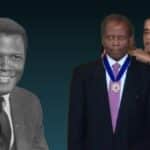SYDNEY, Australia — Former Australian cricketer Andrew Symonds, who has died after a single-vehicle auto accident, was a big-hitting allrounder who built a credible test career and was an exemplar of Australian sport’s prized larrikin tradition. He was 46.
“Australian cricket has lost another of its very best. Andrew was a generational talent instrumental in Australia’s success at World Cups and as part of Queensland’s rich cricket history,” Cricket Australia chairman Lachlan Henderson said in a statement Sunday. “He was a cult figure to many (and) was treasured by his fans and friends.”
Cricket Australia reported Symonds’ death on its website, citing a police statement with details of the accident late Saturday night near the northeastern city of Townsville, Queensland state.
It described Symonds as “a cult hero” and a “larger-than-life figure who drew a widespread fan base during his peak years for his hard-hitting ways and his larrikin persona.”
Laura, Symonds’ wife, told the Courier-Mail newspaper that the family was shocked.
“He was such a big personality, and so much of him in his kids,” she said.
Andrew Symonds had an imposing physical presence, tall, broad-shouldered and dreadlocked, his face daubed in zinc cream. He was born in Birmingham, England, to a father believed to be of Afro-Caribbean heritage. His adoptive parents moved to Australia when he was an infant.
Symonds was able to hit the ball exceptionally hard, and some coaches early in his career dismissed him only as a big-hitter whose untempered appetite for sixes would limit his progress.
But he also could bowl sharp, medium pace and off-breaks and was an athletic fielder who was able to build a credible test career.
Symonds played 26 test matches for Australia from 2004-to 2008, posting two centuries, but he was better known as a limited-overs specialist. He played 198 one-day internationals for Australia and won World Cup titles in 2003 and 2007.
The 2007-2008 season was his most prolific in test cricket and was capped by superb innings of 162 against India at the Sydney Cricket Ground.
The same year he famously felled a naked pitch invader during a one-day international against India at the Gabba ground in Brisbane, hitting him with a rugby-style shoulder charge.
He explained years later that he’d been raised not to take a backward step.
“In the heat of competition, there’s a lot of adrenaline, and when someone interrupts the match like that, it can be frustrating,” he said.
Symonds was a fan of rugby league. Australia’s National Rugby League planned to hold a minute of silence for the cricket star ahead of its match Sunday between the North Queensland Cowboys and Wests Tigers in Brisbane.
In one-day internationals, among his best innings was an unbeaten 143 from 125 balls against Pakistan at the 2003 World Cup when he was far from established in the Australian team. Australia went on to win the tournament.
After retiring as a player, Andrew Symonds became a popular commentator for cricket broadcasts.
Former Australian captain Allan Border said Symonds “hit the ball a long way and just wanted to entertain.
“He was, in a way, a little bit of an old-fashioned cricketer,” Border told the Nine Network. “He was an adventurer and loved his fishing, hiking, and camping. People liked his very laid-back style.”
Andrew Symonds famously attended an early contract meeting with Australian Cricket chief executive Malcolm Speed bare-footed and wearing a cowboy hat. He retained that disdain for convention throughout his career, which was part of his appeal to fans.
But he increasingly came into conflict with authority late in his career. In 2008 he missed Australia’s one-day series against Bangladesh after going fishing when he was required to attend a team meeting. Before the 2009 Twenty20 World Cup, he was also disciplined for breaching team rules around alcohol.
Early in his career, he was a close friend and confederate of Michael Clarke, who became Australia’s captain. The pair fell out when Clarke denounced aspects of Symonds’ conduct, and Symonds publicly criticized Clarke’s leadership.
“Some former teammates will take his side and feed his conviction that I let him down and put ambition ahead of mateship,” Clarke wrote in his autobiography My Story. “I would say that he let me down too — that if he had understood mateship as a two-way street, he would have seen that I had to do what was right for the whole team.”
But another former captain, Mark Taylor, saw Symonds as an imposing man able to preserve almost a child-like love of cricket amid the complexity of professionalism.
“He was an entertainer in an era where professionalism is a throwaway word that we use probably too often,” Taylor said on the Nine Network. “He wanted to go out there, have fun, and play the game he remembered as a kid.
“At times, he got in trouble for not going to training or maybe having a few too many beers, but that is how he lived his life and wanted to play his cricket.”
Andrew Symonds’ loss is another bitter blow for Australian cricket after the death in Thailand in March of legendary leg-spinner Shane Warne. Wicketkeeper Rod Marsh also died in March, aged 74.
AP Sports Writer John Pye contributed to this report from Brisbane, Australia.
More AP cricket: https://apnews.com/hub/cricket and https://twitter.com/AP_Sports
Steve Mcmorran, The Associated Press







